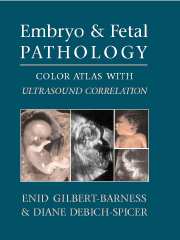Book contents
- Frontmatter
- Contents
- Foreword by John M. Opitz
- Preface
- Acknowledgments
- 1 The Human Embryo and Embryonic Growth Disorganization
- 2 Late Fetal Death, Stillbirth, and Neonatal Death
- 3 Fetal Autopsy
- 4 Ultrasound of Embryo and Fetus: General Principles
- 5 Abnormalities of Placenta
- 6 Chromosomal Abnormalities in the Embryo and Fetus
- 7 Terminology of Errors of Morphogenesis
- 8 Malformation Syndromes
- 9 Dysplasias
- 10 Disruptions and Amnion Rupture Sequence
- 11 Intrauterine Growth Retardation
- 12 Fetal Hydrops and Cystic Hygroma
- 13 Central Nervous System Defects
- 14 Craniofacial Defects
- 15 Skeletal Abnormalities
- 16 Cardiovascular System Defects
- 17 Respiratory System
- 18 Gastrointestinal Tract and Liver
- 19 Genito-Urinary System
- 20 Congenital Tumors
- 21 Fetal and Neonatal Skin Disorders
- 22 Intrauterine Infection
- 23 Multiple Gestations and Conjoined Twins
- 24 Metabolic Diseases
- Appendices
- Index
Foreword by John M. Opitz
Published online by Cambridge University Press: 23 February 2010
- Frontmatter
- Contents
- Foreword by John M. Opitz
- Preface
- Acknowledgments
- 1 The Human Embryo and Embryonic Growth Disorganization
- 2 Late Fetal Death, Stillbirth, and Neonatal Death
- 3 Fetal Autopsy
- 4 Ultrasound of Embryo and Fetus: General Principles
- 5 Abnormalities of Placenta
- 6 Chromosomal Abnormalities in the Embryo and Fetus
- 7 Terminology of Errors of Morphogenesis
- 8 Malformation Syndromes
- 9 Dysplasias
- 10 Disruptions and Amnion Rupture Sequence
- 11 Intrauterine Growth Retardation
- 12 Fetal Hydrops and Cystic Hygroma
- 13 Central Nervous System Defects
- 14 Craniofacial Defects
- 15 Skeletal Abnormalities
- 16 Cardiovascular System Defects
- 17 Respiratory System
- 18 Gastrointestinal Tract and Liver
- 19 Genito-Urinary System
- 20 Congenital Tumors
- 21 Fetal and Neonatal Skin Disorders
- 22 Intrauterine Infection
- 23 Multiple Gestations and Conjoined Twins
- 24 Metabolic Diseases
- Appendices
- Index
Summary
With the publication of Embryo and Fetal Pathology, developmental pathology has come full circle. It is no coincidence that the development of this branch of biology was almost exactly congruent with that of morphology. And while morphology, since its founding by Goethe and Burdach, respectively, in 1796 and 1800, continued to grow slowly but steadily, especially after shedding its neo-Platonic philosophical trappings, developmental pathology matured in fits and spurts with some astonishing hiatus, which to date remain unexplained by the historians of biology. And while the description of the malformed fetus, some of them with remarkable accuracy, antedated the 19th century, it was not until 18021805 that we can date a modern (i.e., scientific) analysis of malformations. It was on the 8th of April 1802 that Joannes FridericusMeckel, Halensis, at the age of 21, publice defendet his dissertatio inauguralis “de cordis conditionibus abnormibus” (on congenital heart defects, published in Rei's Archive three years later).
What happened between 1802 and 1805 in Meckel's life was of the utmost importance for the subsequent development of the field, for it was during that time that the prodigiously gifted, young Meckel working with Cuvier in Paris became master of comparative anatomy but with the difference that, while Cuvier ignored embryonic and fetal stages and considered malformations irrelevant, Meckel did not. Indeed, it was Meckel's attention to prenatal stages of life, whether normal or abnormal, that led to the formulation of the concepts of vestigia (persistence of embryonic/fetal stages) and atavisms (recurrence of an ancestral stage) and an initial recapitalulationist attempt to relate evolution and development.
- Type
- Chapter
- Information
- Embryo and Fetal PathologyColor Atlas with Ultrasound Correlation, pp. ix - xiiPublisher: Cambridge University PressPrint publication year: 2004

